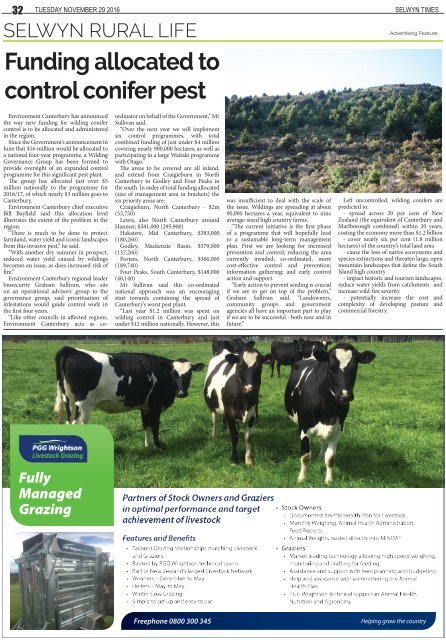Create successful ePaper yourself
Turn your PDF publications into a flip-book with our unique Google optimized e-Paper software.
32<br />
Tuesday <strong>November</strong> <strong>29</strong> <strong>2016</strong><br />
SELWYN RURAL LIFE<br />
SELWYN TIMES<br />
Funding allocated to<br />
control conifer pest<br />
Environment Canterbury has announced<br />
the way new funding for wilding conifer<br />
control is to be allocated and administered<br />
in the region.<br />
Since the Government’s announcement in<br />
June that $16 million would be allocated to<br />
a national four-year programme, a Wilding<br />
Governance Group has been formed to<br />
provide oversight of an expanded control<br />
programme for this significant pest plant.<br />
The group has allocated just over $5<br />
million nationally to the programme for<br />
<strong>2016</strong>/17, of which nearly $3 million goes to<br />
Canterbury.<br />
Environment Canterbury chief executive<br />
Bill Bayfield said this allocation level<br />
illustrates the extent of the problem in the<br />
region.<br />
“There is much to be done to protect<br />
farmland, water yield and iconic landscapes<br />
from this invasive pest,” he said.<br />
“With another dry summer in prospect,<br />
reduced water yield caused by wildings<br />
becomes an issue, as does increased risk of<br />
fire.”<br />
Environment Canterbury regional leader<br />
biosecurity Graham Sullivan, who sits<br />
on an operational advisors’ group to the<br />
governance group, said prioritisation of<br />
infestations would guide control work in<br />
the first four years.<br />
“Like other councils in affected regions,<br />
Environment Canterbury acts as coordinator<br />
on behalf of the Government,” Mr<br />
Sullivan said.<br />
“Over the next year we will implement<br />
six control programmes, with total<br />
combined funding of just under $4 million<br />
covering nearly 900,000 hectares, as well as<br />
participating in a large Waitaki programme<br />
with Otago.”<br />
The areas to be covered are all inland,<br />
and extend from Craigieburn in North<br />
Canterbury to Godley and Four Peaks in<br />
the south. In order of total funding allocated<br />
(size of management area in brackets) the<br />
six priority areas are:<br />
Craigieburn, North Canterbury - $2m<br />
(53,750)<br />
Lewis, also North Canterbury around<br />
Hanmer, $581,000 (<strong>29</strong>5,900)<br />
Hakatere, Mid Canterbury, $383,000<br />
(180,260)<br />
Godley, Mackenzie Basin, $379,000<br />
(137,260)<br />
Porters, North Canterbury, $366,000<br />
(189,740)<br />
Four Peaks, South Canterbury, $148,000<br />
(40,140)<br />
Mr Sullivan said this co-ordinated<br />
national approach was an encouraging<br />
start towards containing the spread of<br />
Canterbury’s worst pest plant.<br />
“Last year $1.2 million was spent on<br />
wilding control in Canterbury and just<br />
under $12 million nationally. However, this<br />
was insufficient to deal with the scale of<br />
the issue. Wildings are spreading at about<br />
90,000 hectares a year, equivalent to nine<br />
average-sized high country farms.<br />
“The current initiative is the first phase<br />
of a programme that will hopefully lead<br />
to a sustainable long-term management<br />
plan. First we are looking for increased<br />
prevention and control; reducing the area<br />
currently invaded; co-ordinated, more<br />
cost-effective control and prevention;<br />
information gathering; and early control<br />
action and support.<br />
“Early action to prevent seeding is crucial<br />
if we are to get on top of the problem,”<br />
Graham Sullivan said. “Landowners,<br />
community groups and government<br />
agencies all have an important part to play<br />
if we are to be successful - both now and in<br />
future.”<br />
Left uncontrolled, wilding conifers are<br />
predicted to:<br />
- spread across 20 per cent of New<br />
Zealand (the equivalent of Canterbury and<br />
Marlborough combined) within 20 years,<br />
costing the economy more than $1.2 billion<br />
- cover nearly six per cent (1.8 million<br />
hectares) of the country’s total land area<br />
- cause the loss of native ecosystems and<br />
species extinctions and threaten large, open<br />
mountain landscapes that define the South<br />
Island high country<br />
- impact historic and tourism landscapes,<br />
reduce water yields from catchments and<br />
increase wild-fire severity<br />
- potentially increase the cost and<br />
complexity of developing pasture and<br />
commercial forestry.<br />
Fully<br />
Managed<br />
Grazing<br />
Freephone 0800 300 345<br />
Helping grow the country


















